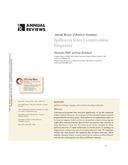| dc.contributor.author | Pfaff, Alexander | |
| dc.contributor.author | Robalino, Juan | |
| dc.date.accessioned | 2020-08-31T21:38:07Z | |
| dc.date.available | 2020-08-31T21:38:07Z | |
| dc.date.issued | 2017-10 | |
| dc.identifier.uri | https://doi.org/10.1146/annurev-resource- 100516-053543 | |
| dc.identifier.uri | https://repositorio.catie.ac.cr/handle/11554/9558 | |
| dc.description.abstract | Conservation programs have increased significantly, as has the evaluation of their impacts. However, the evaluation of their potential impacts beyond program borders has been scarce. Such spillovers can significantly reduce or increase net impacts. In this review, we discuss how conservation programs might affect outcomes beyond their borders and present some evidence of when they have or have not. We focus on five major channels by which spillovers can arise: (1) input reallocation; (2) market prices; (3) learning; (4) nonpecuniary motivations; and (5) ecological-physical links. We highlight evidence for each channel and emphasize that estimates often may reflect multiple channels. Future research could test for spillovers within different contexts and could separate the effects of different channels. | es_ES |
| dc.language.iso | en | es_ES |
| dc.publisher | Annual Reviews, Palo Alto, California (Estados Unidos) | es_ES |
| dc.relation.ispartof | Annual Review of Resource Economics, Volumen 9 (2017), pages 299-315 | es_ES |
| dc.rights | info:eu-repo/semantics/restrictedAccess | es_ES |
| dc.subject | CONSERVACION | es_ES |
| dc.subject | PRECIO | es_ES |
| dc.subject | MERCADO | es_ES |
| dc.subject | EVALUACION | es_ES |
| dc.subject | CAMBIO CLIMÁTICO | es_ES |
| dc.subject | DEFORESTACIÓN | es_ES |
| dc.subject | SERVICIOS DE LOS ECOSISTEMAS | es_ES |
| dc.subject | FLUJOS DE AGUA | es_ES |
| dc.subject | POLITICAS | es_ES |
| dc.subject | BOSQUE | es_ES |
| dc.title | Spillovers from Conservation Programs | es_ES |
| dc.type | Artículo | es_ES |


